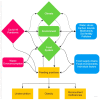Interlinkages between Climate Change and Food Systems: The Impact on Child Malnutrition-Narrative Review
- PMID: 36678287
- PMCID: PMC9865989
- DOI: 10.3390/nu15020416
Interlinkages between Climate Change and Food Systems: The Impact on Child Malnutrition-Narrative Review
Abstract
The pandemics of obesity, undernutrition, and climate change represent severe threats to child health. They co-occur; interact with each other to produce sequelae at biological, psychological, or social levels; and share common underlying drivers. In this paper, we review the key issues concerning child diet and nutritional status, focusing on the interactions with climate and food systems. Inadequate infant and young child feeding practices, food insecurity, poverty, and limited access to health services are the leading causes of malnutrition across generations. Food system industrialization and globalization lead to a double burden of malnutrition, whereby undernutrition (i.e., stunting, wasting, and deficiencies in micronutrients) coexists with overweight and obesity, as well as to harmful effects on climate. Climate change and the COVID-19 pandemic are worsening child malnutrition, impacting the main underlying causes (i.e., household food security, dietary diversity, nutrient quality, and access to maternal and child health), as well as the social, economic, and political factors determining food security and nutrition (livelihoods, income, infrastructure resources, and political context). Existing interventions have the potential to be further scaled-up to concurrently address undernutrition, overnutrition, and climate change by cross-cutting education, agriculture, food systems, and social safety nets. Several stakeholders must work co-operatively to improve global sustainable nutrition.
Keywords: COVID-19; breastfeeding; children; climate change; complementary feeding; food system; obesity; socioeconomic inequalities; sustainable nutrition; undernutrition.
Conflict of interest statement
The authors declare no conflict of interest.
Figures


Similar articles
-
Climate change and nutrition: creating a climate for nutrition security.Food Nutr Bull. 2013 Dec;34(4):533-47. doi: 10.1177/156482651303400415. Food Nutr Bull. 2013. PMID: 24605700
-
Household food insecurity and dietary diversity as correlates of maternal and child undernutrition in rural Cambodia.Eur J Clin Nutr. 2015 Feb;69(2):242-6. doi: 10.1038/ejcn.2014.161. Epub 2014 Aug 13. Eur J Clin Nutr. 2015. PMID: 25117993
-
COVID-19 pandemic and mitigation strategies: implications for maternal and child health and nutrition.Am J Clin Nutr. 2020 Aug 1;112(2):251-256. doi: 10.1093/ajcn/nqaa171. Am J Clin Nutr. 2020. PMID: 32559276 Free PMC article. Review.
-
Community-level interventions for improving access to food in low- and middle-income countries.Cochrane Database Syst Rev. 2020 Aug 5;8(8):CD011504. doi: 10.1002/14651858.CD011504.pub3. Cochrane Database Syst Rev. 2020. PMID: 32761615 Free PMC article.
-
Community-level interventions for improving access to food in low- and middle-income countries.Cochrane Database Syst Rev. 2020 Jul 28;7(7):CD011504. doi: 10.1002/14651858.CD011504.pub2. Cochrane Database Syst Rev. 2020. Update in: Cochrane Database Syst Rev. 2020 Aug 5;8:CD011504. doi: 10.1002/14651858.CD011504.pub3. PMID: 32722849 Free PMC article. Updated.
Cited by
-
Infant and Young Child Feeding Practices and Health.Nutrients. 2023 Feb 27;15(5):1184. doi: 10.3390/nu15051184. Nutrients. 2023. PMID: 36904182 Free PMC article.
-
Climate change and tuberculosis: an analytical framework.medRxiv [Preprint]. 2025 Feb 20:2025.02.18.25322451. doi: 10.1101/2025.02.18.25322451. medRxiv. 2025. PMID: 40034780 Free PMC article. Preprint.
-
Using Machine Learning to Fight Child Acute Malnutrition and Predict Weight Gain During Outpatient Treatment with a Simplified Combined Protocol.Nutrients. 2024 Dec 6;16(23):4213. doi: 10.3390/nu16234213. Nutrients. 2024. PMID: 39683605 Free PMC article.
-
Incremental financial costs of strengthening large-scale child nutrition programs in Bangladesh, Ethiopia, and Vietnam: retrospective expenditure analysis.Global Health. 2025 Apr 21;21(1):21. doi: 10.1186/s12992-025-01118-3. Global Health. 2025. PMID: 40259386 Free PMC article.
-
Adherence to WHO guidelines on severe pneumonia management in children and its impact on outcome: an observational study at Jinka General Hospital in Ethiopia.Front Public Health. 2023 Jul 27;11:1189684. doi: 10.3389/fpubh.2023.1189684. eCollection 2023. Front Public Health. 2023. PMID: 37575120 Free PMC article.
References
-
- World Health Organization. United Nations Children’s Fund (UNICEF) World Bank . Levels and Trends in Child Malnutrition: UNICEF/WHO/The World Bank Group Joint Child Malnutrition Estimates: Key Findings of the 2021 Edition. World Health Organization; Geneva, Switzerland: 2021.
-
- Clark H., Ghebreyesus T.A., Albrectsen A.-B., Alcocer J., Alden E., Azoulay A., Billingsley S., Blum R.W., Bhushan R., Byanyima W., et al. Uniting for Adolescents in COVID-19 and Beyond. BMJ. 2021;372:n719. doi: 10.1136/bmj.n719. - DOI
-
- Watts N., Amann M., Arnell N., Ayeb-Karlsson S., Belesova K., Boykoff M., Byass P., Cai W., Campbell-Lendrum D., Capstick S., et al. The 2019 Report of The Lancet Countdown on Health and Climate Change: Ensuring That the Health of a Child Born Today Is Not Defined by a Changing Climate. Lancet. 2019;394:1836–1878. doi: 10.1016/S0140-6736(19)32596-6. - DOI - PMC - PubMed
-
- Watts N., Amann M., Arnell N., Ayeb-Karlsson S., Beagley J., Belesova K., Boykoff M., Byass P., Cai W., Campbell-Lendrum D., et al. The 2020 Report of The Lancet Countdown on Health and Climate Change: Responding to Converging Crises. Lancet. 2021;397:129–170. doi: 10.1016/S0140-6736(20)32290-X. - DOI - PMC - PubMed

